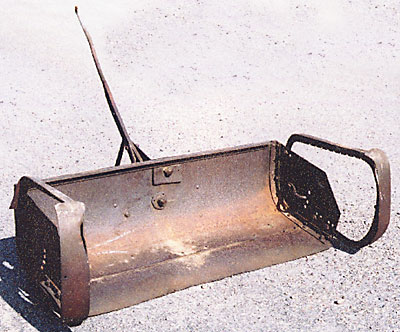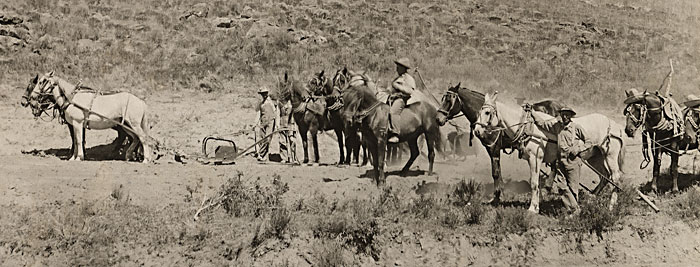 |
||
|
Roadbuilding in the mountains of Idaho with horses and Fresno scrapers.
|
|||
|
The Conant Dugway is a big gully (Or small canyon) that connects the high, hilly dry farms East of Ririe Idaho with the Snake River where it enters the small Conant Valley. In the early 1900's a winding road was built down this gully so that the newly arrived automobiles could travel from Idaho Falls, Idaho to Swan Valley, Idaho and on to Wyoming's Star Valley or Idaho's Teton Valley. This road was refered to as the Conant Dugway. When I was growing up on a farm in Idaho (in the 1930's, 1940's and 1950's) we had a Fresno scraper. My dad, Kenneth Morgan, told me he used it to work on the Conant Dugway. I remember him saying there were several roads built down the dugway, a small one first (a wagon road that contoured along the South side), and then larger ones which were built on the North side. Men who were hired to work on this road project brought their own horses and slip scraper. The Fresno scraper was a big open front bucket with a steel bracket attached to swivels on the ends and a handle on the back. Horses were hooked to the steel bracket to pull it and a man walked behind working the handle. Lifting the handle caused the bucket to bite into the earth and pick up a load of soil. Lowering the handle and holding it down allowed you to slide the scraper along with a load of soil until you were ready to dump it. Lifting the handle all the way up flipped the scraper up onto a pair of skids, dumping the load. It could then be pulled along, upside down and empty, on the skids, until you were ready to load it up again. The slip scraper could be pulled by a team of two horses for light duty earth moving. But for heavier work in hilly country a team of four horses was required. The task for the man on the end of the handle was very hard and often dangerous work. He had to drive the horses while loading and unloading the scraper by lifting or lowering the handle. A fully loaded scraper was heavy and required a strong lift to flip it over and empty it. This picture of men building the Conant Dugway road with horses and Fresno scrapers is included because it was found in a collection of Morgan/Radford family pictures and because I know Morgan and Radford men worked on the project. There may be Radford men in the picture, but if not, we know they were there. Women from our Morgan/Radford families sometimes worked in the camps as cooks.  Pictured above is the original Fresno scraper. This scraper was large enough to require a team of two or four horses. It was very hard work for the human operator, who had to ride the long handle at the rear, tip it up to dig it into the soil to fill it, and pull it down so it would stop digging in and slide along to move the soil to where the operator wanted it, and then lift it up and over to empty it. These scrapers were used on the Conant Dugway for most of the jobs that required moving of soil.
A story about scrapers from the Miskin Scraper Works in Idaho. Arthur R. Miskin had a job helping to build a canal in eastern Idaho. He used a scraper with a long handle on the back of the pan that made it dig, slide or dump. The team of horses pulled it while Arthur walked behind in the dust, controlling the pan with the long handle. Another operator had his pan catch on a rock and the long handle flipped up under his arm and threw him up onto the horses. They ran away tromping the poor fellow before the pan was dragged over him. Arthur came home that night and exclaimed "I can make a better scraper than that." And he did. It had wheels to haul a bigger load, a seat to ride on, and foot controls that let his hands free to hold the reins. It was an instant success wherever it was shown. The Miskin Scraper Works in Ucon, Idaho was started as a result in 1917 and today is the world's oldest manufacturer of scrapers for farm use. (Note- The Miskin Scraper Works is still operated by the Miskin family) |
|||
